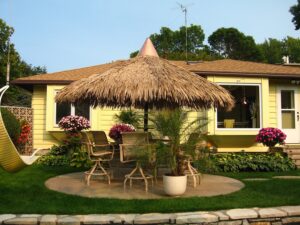Sabal palm Thatch




Sabal Palm Thatch
gives a very tropical look to the area it is being used in.
The heartiest of the natural thatches, used extensively throughout the United States, It is cut from the Sabal palm tree that grows in the deep woods of the Southeast. The leaves are fresh cut on demand and start off green when first cut. They quickly start changing to their golden tan color after just a few days, gradually they will change to a greyish tan color for the rest of the thatch’s life expectancy. This is a replenishable, renewable and earth friendly “green” resource.
Sabal palm thatch can be used on any exterior or interior roof or frame structures in place of shingles. It is the best natural thatch roof material we offer and it lasts the longest on open frame roofs with a 33-37 degree pitch. Use on umbrella frames, gazebos, tiki huts, palapas, chickee huts. Once on, it can be left natural with a fine whispy edge or trimmed to give an edgy look.
Palm thatch is good for any climate with no need to cover it. Withstanding high winds unlike canvas or shingle roofs, wind can escape through it so there is no uplift. Wind, water and snow resistant. When installed as instructed, sabal palm thatch is completely waterproof, therefore the customer may put electronics, fans, lights etc. under their tiki hut.
Natural sabal palm thatch can be fire retarded after a curing period of approximately 2-3 months when the leaves are completely dry. Fire retardant is made specifically for thatch. Suncoast Tiki Huts can supply our customers with the fire retardant specifically for thatch, For our in state customers, we can apply fire retardant for a fee.
- Longevity is 4-6 years in wet climates and longer in dry climates. It will last indefinitely indoors.
- Very low maintenance
- Can be fire retarded
Installation:
Can be installed on any wood subroof, shingles or battons but best if used with an open frame. Minimum suggested pitch is 30 degrees. Can be used on others pitches but may effect the longevity of the thatch, steeper pitches let the water drain off better. Install the leaves in layered courses starting with the bottom row being your 2nd row of purlins. The purlins should be spaced at 16″ on center with your bottom row being up to 24″. Suggested fastening is a 1 .75″ roofing nail.
find out how many leaves you will need… multiply the length and width of your tiki hut roof L x W x 1.252 = sqft Sqft x 5 for how many leaves you will need.
Step by step thatching video supplied with purchase.






